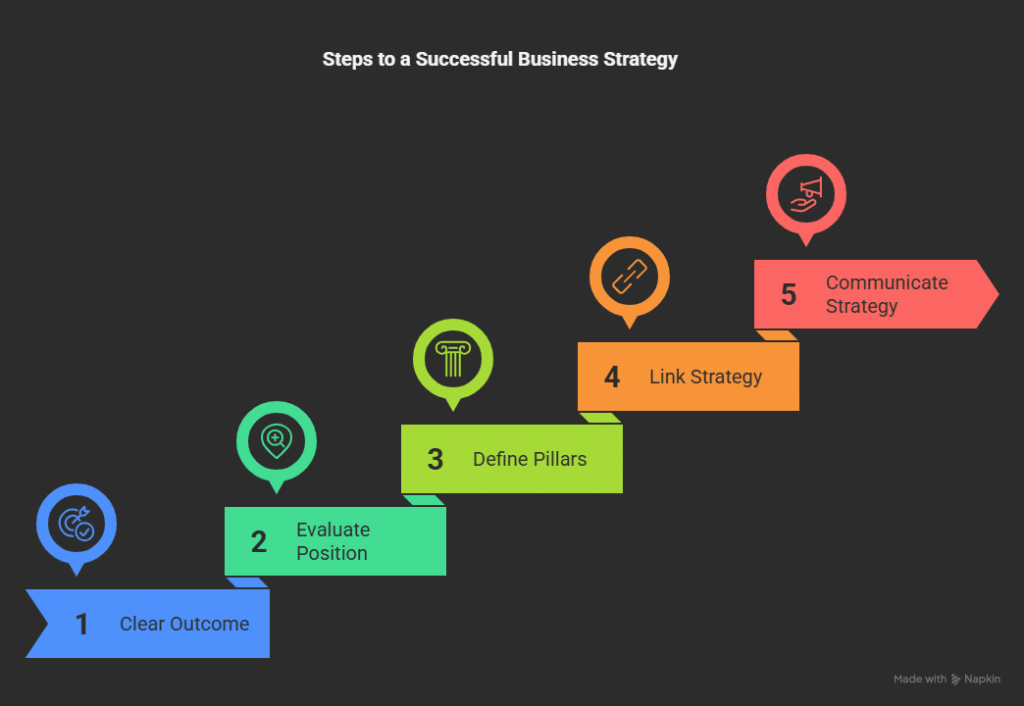Why Strategy Still Matters
How to write a business strategy plan is one of the areas businesses struggle with the most. Growth doesn’t happen by accident. Without a clear business strategy, teams get pulled in different directions. Leaders chase new ideas, but results stall. Strategy creates alignment. It sharpens focus, filters distractions, and turns intention into action.
When you build a strategy that drives results, it’s not just a paper exercise. It becomes the blueprint for execution. If you’re ready to create a strategy your team can rally around, let’s chat! This blog will walk you through the same principles used to help CEOs and leadership teams learn how to write a business strategy plan that drives growth.

1. Start With a Clear Outcome
Every strategy must answer one question: Where are we going?
Without a shared destination, priorities fragment and progress slows. Growth-oriented companies get clear on the result they want. Whether it’s market expansion, operational scale, or team development, the outcome should be measurable and time-bound.
In our work with leaders, we begin with a simple question: “What will success look like 12 months from now?” That answer becomes the lens through which all decisions are filtered.
2. Evaluate Your Current Position
Before deciding where to go,
Review client feedback. Assess internal data. Look at competitor movement. A strategic plan grounded in reality will always outperform one built on assumptions.
In many strategy sessions, clarity comes not from new ideas—but from addressing the tensions that already exist. When leaders avoid difficult truths, they build plans on shaky ground. That’s why we recommend using structured facilitation like productive strategy sessions to surface the full picture. These activities can serve as the foundation for learning how to write a business strategy plan for your next phase of growth.
3. Define 3–5 Strategic Pillars
Pillars are the high-level themes that organize your efforts. Think of them as the scaffolding for execution.
Some examples:
- Strengthen client retention
- Build a leadership pipeline
- Improve operational efficiency
- Expand market presence
Each pillar should have a clear owner, defined outcome, and timeline. This keeps your team focused and prevents drift. When priorities are visible, execution becomes easier to manage and track. Understanding the 3-5 strategic pillars and how to write a business strategy plan is vital.
According to Gallup, building leaders at every level is one of the highest-return investments organizations can make. Strategic pillars are how you prioritize that investment effectively.
4. Link Strategy to Execution
The best strategies don’t live in slide decks. They show up in how people act every day. Understanding how to write a business strategy is key, and it is learned through action.
Build systems that link your pillars to real-world actions. Assign initiative owners. Use KPIs that measure progress. Hold monthly reviews. Your leadership team must reinforce direction consistently—not just during annual planning retreats.
Integrating strategic goals into your one-page strategic plan and conducting weekly check-ins will keep strategy at the forefront of daily decisions. This makes strategy an ongoing habit, not a seasonal project.
As PerformanceManagement.io explains, leaders play a crucial role in shaping performance systems. They set the tone for accountability and follow-through.
5. Communicate Until It Sticks
Strategy fails when it’s hidden. You can’t expect alignment if no one knows the plan. That’s why it’s crucial to know how to write a business strategy plan.
Leaders must repeat the strategy across all layers of the organization—team meetings, performance reviews, onboarding, and decision-making processes. It’s not about creating more slides. It’s about reinforcing what matters most, again and again.
When people understand how their daily work contributes to larger goals, motivation increases. MIT Sloan notes that group leadership initiatives thrive on clarity and shared ownership.
Avoid These 5 Common Strategy Pitfalls
1. Building It in a Vacuum
Strategy isn’t something you create alone in a room. The best strategies are shaped by diverse perspectives—especially those of cross-functional leaders and your team. Without input from key stakeholders, you’re likely to miss critical context. Worse, you’ll struggle to gain the buy-in needed for successful implementation.
Leaders often fall into the trap of crafting strategies in isolation, thinking they’re the only ones who know what’s best. This can result in blind spots, and a lack of understanding across the organization. Instead, take a collaborative approach to strategy development. Use a mix of insight gathering and facilitated conversations to bring the right voices into the process. The more people who understand and feel part of the strategy, the easier it will be to execute.
2. Mistaking Tactics for Strategy
It’s easy to confuse tactics with strategy, but they are fundamentally different. A tactic is an action; strategy is the framework within which that action fits. For example, updating your CRM system is a tactic. Streamlining your entire sales cycle, aligning it with your customer journey, and ensuring it supports your growth goals—that’s strategy.
The strategy is the “why” behind every action, while tactics define the “how.” Without clear strategic direction, you risk implementing isolated actions that don’t move the needle in the right direction. Keep them distinct in your mind and in your planning, and your team will be much more effective in their execution.
3. Skipping Hard Choices
A real strategy requires difficult trade-offs. If everything is a priority, nothing is. Too often, teams and leaders hesitate to make these tough decisions, fearing the fallout from letting go of initiatives that have been in place for years. The fear of abandoning the past can paralyze an organization and leave them moving in too many directions at once.
Pruning your focus is essential to effective strategy. It’s about making intentional choices to drop low-value or outdated activities in favor of higher-impact initiatives. While it may feel uncomfortable, this focus is what propels long-term success. Leaders must commit to these hard choices and help their teams understand why certain areas must be deprioritized for the greater good.
4. Writing to Impress, Not to Execute
A strategy should be simple and clear, not a glorified document designed to impress executives or board members. If your strategy sounds good but no one can explain it clearly, it’s likely too convoluted. Remember: strategy isn’t about showing off; it’s about ensuring everyone, from top executives to frontline managers, understands the goals, actions, and rationale behind the plan.
Use direct language. Stick to a small set of pillars or focus areas. Every leader should be able to articulate the strategy clearly without referring to slides or lengthy documents. The key to successful execution is clarity. If the team can’t explain the strategy, they can’t execute it.
5. Forgetting Accountability
Without execution systems in place, even the best strategy can get lost in the shuffle of day-to-day work. When accountability isn’t built into the process, the strategy will fade into the background, overtaken by urgent emails and unexpected challenges.
To avoid this, build regular review rhythms and measurable outcomes into the strategy itself. Track progress, adjust course when necessary, and ensure everyone involved knows how their work ties into the broader organizational goals. If accountability is part of your strategy from the start, you’ll be much more likely to sustain momentum and deliver results over time.
What CEOs Must Personally Own
You don’t have to write every section of the plan—but you must champion it.
As CEO, your behavior communicates more than any slide deck. If you talk about the strategy in quarterly meetings but ignore it during budget planning, your team will follow your lead.
Your job is to keep the strategy visible, consistent, and non-negotiable. As Harvard Business Review outlines, executive coaching helps leaders align intention and impact. You set the tone.
What Makes a Strategy Work?
Knowing how to write a business strategy can be tricky. Great strategies aren’t complicated. They’re clear.
Your strategy should be:
- Easy to communicate
- Aligned to current realities
- Anchored to key initiatives
- Reviewed and adjusted often
You’ll know it’s working when it shapes how decisions are made and where resources go. Strategy isn’t something separate from the business. It’s how the business makes progress.
Forbes reinforces this by showing how executive coaching improves strategic thinking and adaptability. Leaders perform better when they operate from a clear, consistent plan.
A Few Key Tools to Support Your Plan
If you’re serious about turning strategy into results, equip your leaders with tools that work:
- Strategic alignment sessions focus on clarity and follow-through
- Executive coaching to strengthen individual leadership
- A high performing team framework that reinforces collaboration and accountability
- Simplified, visualized plans that can be reviewed weekly
And remember: strategy should evolve. As your business grows, revisit your pillars and adapt your priorities.
FAQs

What is a business strategy with examples?
A business strategy is a high-level plan for how a company achieves its goals. For example, a consulting firm might focus on entering new markets while deepening client relationships through strategic partnerships and thought leadership.
What are the 5 Ps of business strategy?
The 5 Ps of business strategy are Product, Price, Place, Promotion and People—these foundational elements guide how a company competes and delivers value.
How do you write a business strategy?
To write a business strategy, start by defining the goal. Assess your current position. Choose 3–5 strategic pillars and translate them into initiatives. Communicate and revisit them regularly.
What makes a strong strategy?
A strong strategy is clear, actionable, and linked to measurable outcomes. A strong strategy guides decision-making and aligns the team’s efforts.
Why do most strategies fail?
Most strategies fail due to a lack of clarity, poor communication, and no accountability. Execution always reveals the strength of your plan.
How to Write a Business Strategy That Drives Growth: Conclusion
By focusing on clarity, alignment, and personal accountability, corporate executive coaching becomes a direct investment in performance. For CEOs and senior leaders, it offers the kind of support that turns insight into action.
If you want personalized guidance, book a 30-minute call with one of our elite coaches to discover how our services can help you learn how to write a business strategy plan that drives growth










